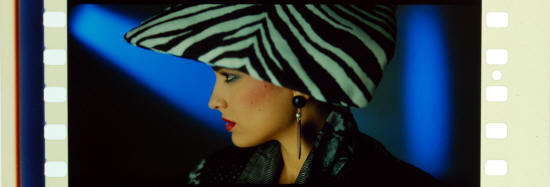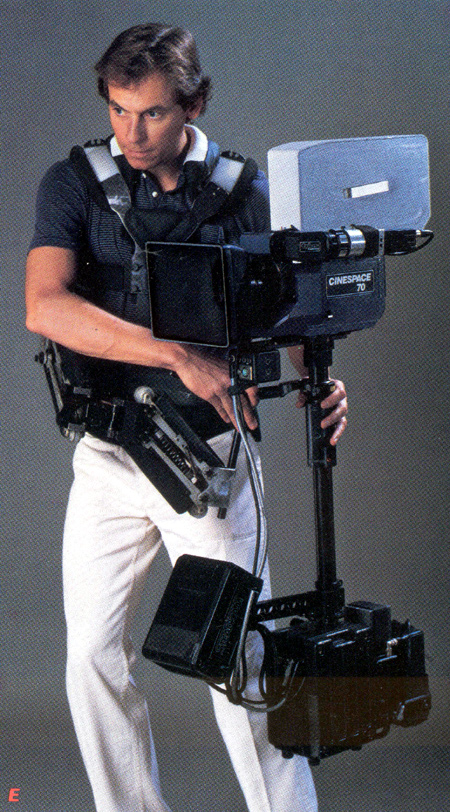CineSpace 70 / ClearVision 2000 by Todd-AO |
This article first appeared in |
| Credits assembled by Lee Parker, Richard Vetter & Thomas Hauerslev | Issue 58 - September 1999 |
|
|
Further in 70mm reading: |
Notes about the filming |
|
 The “Swamp” sequence
is the shot looking up at the tree tops with the sky in the background.
Frame from 35mm print down of Cinespace 70 demo film. The “Swamp” sequence
is the shot looking up at the tree tops with the sky in the background.
Frame from 35mm print down of Cinespace 70 demo film. “Cinespace 70” was the first 70mm film ever edited entirely with video. The film was edited with an off-line Panasonic 3/4" video system. As a 70mm video telecine was unavailable at that time, the 70mm footage was telecined with a video camera beam-splitter mirror and a standard Philips DP70/Norelco AA11 70mm movie projector at the UA Pasadena cinema near Los Angeles. The UA Pasedena was not the multiplex UA Pasadena, but an older theater. The telecine was done at the older theater down the street with a 60 ft SILVER SCREEN! There were two AA's there set up to project 70mm 3D. The CineSpace 70 Demo was projected at 60 foot lamberts! It was the brightest place in the world. Using the beam splitter from the 3D camera system, Lee Parker was able to get the video camera on the same optical axis as the projector. The mirror turned the light 90 degrees to a flat white card about 3 feet across. This made a very bright image. Lee Parker did this to get maximum color saturation in the video. Even today you look at the video and you can't tell it was done without a telecine. A propriatary computer program turned the video time code numbers into film key code numbers and the work print was cut to match the video. The program was later developed into a full featured program used by “Baraka” and by Douglas Trumball at “Luxor”. The software is still licensed to large format films and is called CONFORM-IT. The sound was mixed to cue marks on clear leader as there were no "rock & roll" mixing projectors for 70mm. Lee Parker created the clear leader by interlocking it with the 70mm workprint and marking dissolve points, fades & cuts. It was an easy mix, with only 6 sound changes. Sound is two track stereo spread to 6 tracks. Some sound effects were added at the beginning for the 6 tracks, but this was a visual piece and not a sound piece. Marisa Savage and Pat Banta had never met before they were cast for “Lonely Girl”. They are now married with children. Since the dubber could not run at 30fps, Dr. Richard Vetter spoke slowly and his voice when played at 30fps, was pitched-shifted down to correct for the speed. This is why he sounds a little funny. Steadicam Girl, Mrs. Brandy Parker, is wife of Lee Parker, in her wedding dress. “Spanish Girl” is just one shot of the girl with the Tiger striped hat. That was a beautiful model from Spain who didn't speak a word of English. She was directed through an interpreter. It took 16 takes to get it. Take 16 is the one in the film! The “Swamp” sequence is the shot looking up at the tree tops with the sky in the background. Lots of stuff ended up on the cutting room floor. Unfortunately, we had a camera flare problem on the model shoot stuff and a lot of it wasn't good enough to use. There was a Twist and Shout sequence that couldn't be used. There were lots of aerials with bi-planes over Lake Powell that we couldn't use for the demo print would have been too long. Synopsis: Demonstration Film in four major parts. Purpose of the demonstration film is to show the merits of filming with updated 65mm Todd-AO cameras. Following examples are included: zoom, steadicam, low light, high speed, slow motion, time lapse, CU's to infinity, aerial, under water, exterior, people, nature, daytime, nighttime, extreme wide angle to telephoto etc. Various: Estimated cost of one 70mm print is USD 5000,00 (1999 price). |
|
"Cinespace 70" / "ClearVision 2000" Demonstration Film
|
|
 “Spanish
Girl”
is just one shot of the girl with the Tiger striped hat. That was a
beautiful model from Spain who didn't speak a word of English. She was directed through an interpreter. It took 16 takes to get it.
Take 16 is the one in the film! “Spanish
Girl”
is just one shot of the girl with the Tiger striped hat. That was a
beautiful model from Spain who didn't speak a word of English. She was directed through an interpreter. It took 16 takes to get it.
Take 16 is the one in the film!Toward the end of the 1980s, the motion picture industry had increasingly moved away from doing most actual 65mm film production and everything was being photographed in 35mm. So-called "blow ups", using 35mm originalS to make 70mm release prints, were perceived as "good enough", and more economical. Around this time, some of the principals who had been instrumental in developing the "Todd-AO" and "Dimension 150" processes, and others who were interested in seeing some continuing use of the wonderful Todd-AO cameras, decided it was time to remind the industry about how good things really could be if movies would made as "real" 70mm productions. They got together and decided to produce a demonstration film which would illustrate the capabilities of photography in the original Todd-AO format, meaning 65mm negative film, photographed at the originally-specified 30 frames per second, not the 24 fps that was (and has remained) commonplace. One sidelight ... two major feature films actually were produced at the original 30fps specification, ("Okla.", and "Around the World..."), but 30fps never really caught on as a distribution standard. Well, this new short film would also serve to remind the world that 30fps was the "ultimate" production mode. Photography was done variously, in several locations, around L.A., the southwest, and in a studio. There is even one scene, of especial note to cinematographers, of a cinematographer actually using one of the 70mm cameras mounted on a SteadiCam device, to illustrate that you could in fact achieve "fluidity" of motion using such larger cameras, which was becoming increasingly popular by that time. In a recent conversation, one of the organizers of the film project (and the co-developer of the D-150 process), Dr. Richard Vetter had some additional comments about the film. In his words, the project was to attempt to use a "laundry list" of photographic techiques in the reel, to try to do a bit of every kind of scene a photographer could encounter, to show that it really worked, and worked brilliantly. So, they sought out every lens they could find, from extreme telephoto to extreme wide angle. They did scenes in daylight, twilight, and night times. Interiors and exteriors. Extreme close-ups. Underwater. Slo-motion. Aerial photography. Scenes that would demonstrate other photographic essentials, like bold, saturated colors, and extreme fine detail, such as the wispy, flowing, linen lace material, seen in some shots, worn by a model. For music accompaniment, they selected some uptempo pop music of the time, to give it a fun feeling, but really, the important issue was the image quality. In that interview, Dr. Vetter also mentioned he would like to point out to today's audience here in Karlsruhe that camera films, at the time of the original cinematography, were rather unsophisticated, at least by the standards of 2007. In the 1980s, camera stocks were in Kodak's series known as the "EXR" family of emulsions. Later on would come the major improvements that brought us the "Vision" family of emulsions, followed by today's "Vision II" series. Each one of those represented a refinement & improvement over the previous emulsions in terms of clarity and color rendition. So, if you think the film looks nice now, you can only imagine HOW GREAT it would be if it were to be re-photographed on today's camera stocks! The current film you'll see is a fairly recent print, re-mastered to have a DTS soundtrack. The original prints were done as mag. sound. One original exists at what remains of Todd-AO (now known as "Ascent Media") in L.A., but it's got some scratches and doesn't look as good as it should. Around the year 2000, Dr. Vetter and some other associates decided to give the large format image another chance to show its abilities. They went to the original negative, and made a new copy, in the process changing the name from "Cinespace 70" to "Clearvision 2000". At the start of the reel, before the actual 30fps demonstration reel begins, there is another, shorter demonstration -- of sound. Some of you may have already seen this one. When DTS was being developed, digital sound in the theatre was quite unknown to most production people. DTS wanted to make a big splash, so to speak, and, with the cooperation of Universal Studios (who released the first film in DTS, "Jurassic Park"), they produced a sound demonstration film from some elements in the Universal vaults. Scenes from some Universal films that were recent (at the time, which was around 1973). The demonstration film was made in 35mm only at the time, and came to be somewhat informally known as "The Buzz and Bill Show", the first names of the two studio sound "Mixers" who are featured in the short demo film. After a few years in 35mm only, DTS decided to also develop a 70mm capability, and at that time decided to make a "blow up" to 70mm of "The Buzz and Bill Show". That's what you will see at the start of the reel. HOWEVER --- Buzz and Bill were photographed at the DTS normal standard, 24fps. It works equally well at 30fps, as we will demonstrate. We will first watch "Buzz and Bill" at 24fps, then the screen will go dark and we'll change the speed of the projector to 30fps, and resume the reel, with the original "Cinespace 70"/"Clearvision 2000" film. All sound on one DTS disc, playing both 24 and 30 fps with no changing necessary. Very complete technical details about the production of the "Cinespace 70" film are available on the in70mm.com website! Now, in DTS, at 24 and 30 frames per second ... |
|
|
Go: back
- top - back issues Updated 22-01-25 |

 Original title
Original title